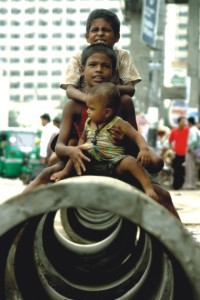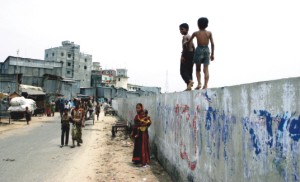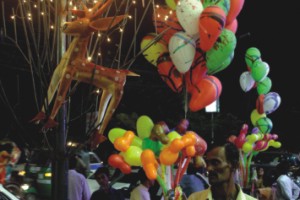|
In Retrospect
Dhakaiyyas :
Losing Their Traditions
Syed Maqsud Jamil
I was born in Dhaka of the late forties and grew up to strike my roots here. My father, however, came from Faridpur. Our link with our village home was lost in the waters of the river Padma. It devoured our village. My mother being a daughter of Dhaka quickened our relocation here. We became permanent residents of Dhaka and I became a 'Dhakaiyya', more precisely, a grafted species among its original inhabitants.
I behold with great fondness the dear memories of Dhaka of the fifties. In the fifties Dhaka was a small provincial town. To the south flowed the river Buriganga as it does even today, although constricted by the greed of the land grabbers. And on the north the old railway tracks marked the end of the town. The suburbs of Ramna and Segunbagicha dotted the solitary stretch up to Tejgaon. The small town throbbed with feisty people endowed with an invigorating sense of humour and a robust demeanour. They were a warm and hospitable people absorbing all classes of people from different districts.
 A city is known by its heritage. For instance, Kolkata is known for its cosmopolitan character, New York is a melting pot, London is multi-racial and Paris is quintessentially French. Dhaka today is a spreading city of 13 million people. And the heritage of Dhaka comprises the Dhakaiyyas. Sadly though, the number of original inhabitants of Dhaka or the Dhakaiyyas is shrinking. The Dhakaiyyas are fast blending into the uni-culture of a growing megacity. They are finding their lifestyle, dialect, ceremonies and cultural practices outmoded and encumbering in the vastness of this uniculture. The Dhakaiyyas are adjusting to the changes and Dhaka is shedding a rich part of its heritage. A city is known by its heritage. For instance, Kolkata is known for its cosmopolitan character, New York is a melting pot, London is multi-racial and Paris is quintessentially French. Dhaka today is a spreading city of 13 million people. And the heritage of Dhaka comprises the Dhakaiyyas. Sadly though, the number of original inhabitants of Dhaka or the Dhakaiyyas is shrinking. The Dhakaiyyas are fast blending into the uni-culture of a growing megacity. They are finding their lifestyle, dialect, ceremonies and cultural practices outmoded and encumbering in the vastness of this uniculture. The Dhakaiyyas are adjusting to the changes and Dhaka is shedding a rich part of its heritage.
The Dhaka of the fifties is now known as Old Dhaka. It is associated with formidable hazards like roads clogged with trucks, rickshaws, pushcarts, vendors, piled up goods and a medley convergence of pedestrians, buyers, labourers and browsers. There is little space left for vehicular traffic, so it takes a bit of courage for someone coming from other parts of the city to negotiate the roads of Old Dhaka. The dear place of my memory has been vandalised by the ubiquitous location of warehouses, shops of all kinds, and restaurants in the ground floor of a large number of houses. It has met the fate of most other expanding cities of this region. The endearing charm of the yesteryears is nowhere to be found in the din and bustle of Old Dhaka.
Dhakaiyyas inhabited the entire expanse of the small town from Gandaria to Hazaribagh. Chawkbazar and Begumbazar formed its core with Urdu Road, Lalbagh, Hussaini Dalan, Satrowza, Becharam Dewry, Aga Nawab Dewry, Mahuttuly, Bangshal, Kasaituly, Nazira Bazar, Siddique Bazar and adjoining areas pulsating with the same love of life.
The Dhakaiyyas spoke two languages, a local dialect of Bangla and a kind of Urdu far from being Urdu. Those speaking Bangla jestingly called the Urdu speaking ones as 'Bazairas' or the outsiders. On the other hand the Urdu speaking ones called the Bangla speaking Dhakaiyyas 'Kuttis', possibly referring to their past role as farmhands in threshing the paddies. But with the general exception of the Nawab family the language of education and written communication for the Dhakaiyyas was all along Bangla both for the Bazairas and the Kuttis. Unfortunately, those speaking a local dialect of Urdu fell into an awkward state of being identified with the Biharis or Non-Bengalis after the birth of Bangladesh. It was socially a compromising situation for them. And they as a matter of convenience made every effort in staying clear of this stigma by abandoning Urdu and using Bangla as the language of the house. Now they speak this language casually and in reliving the camaraderie of the past.
In the Nawab family and in the households speaking the local dialect of Urdu one can recall the mirthful range of chorus songs deriding the entire set of members of the bridegroom's family starting from the father-in-law to the youngest sister-in-law. Thus the ladies of the bride's family welcomed them at the 'Mehendi' or 'Mangni' (engagement) ceremonies. It endowed the marriage ceremony with a festive liveliness. I wonder whether the remnants of the Nawab family are carrying on the custom, I believe not. Ceremonies used to bring out the best part of the playfulness of the Dhakaiyyas. In case of the Nawabs and the 'Sukhbases' (those leading a life of ease) it displayed an infectious warmth and great love for life.
 Kite flying was a popular recreation among the Dhakaiyyas. A kite festival used to take place on the day of Poush Sankranti (the end of the Bangla month of Poush). I remember a big turnout of kite flyers and onlookers at the Armanitola Maidan and at the playground of Armanitola Government High School. The highly ranked kite flyers used 'Hazargazi' (One thousand yard) yarn coloured and coated with a mixture of colouring chemicals, gum acacia and fine grains of grounded broken glasses to render a sharp cutting edge to the yarn. The flying wheels were big and the participants turned out in white lungi and punjabi with a bright red vest inside it and above all a golden chain dangling from the neck. As for the general kite flyers they were happy with 'Belcha' (Spade) brand yarn. In today's Dhaka, kite flying is a rarity. But the city of Lahore and to some extent, the older section of Delhi, is still very keen about indulging in this recreation heralding Basanto or spring. Kite flying was a popular recreation among the Dhakaiyyas. A kite festival used to take place on the day of Poush Sankranti (the end of the Bangla month of Poush). I remember a big turnout of kite flyers and onlookers at the Armanitola Maidan and at the playground of Armanitola Government High School. The highly ranked kite flyers used 'Hazargazi' (One thousand yard) yarn coloured and coated with a mixture of colouring chemicals, gum acacia and fine grains of grounded broken glasses to render a sharp cutting edge to the yarn. The flying wheels were big and the participants turned out in white lungi and punjabi with a bright red vest inside it and above all a golden chain dangling from the neck. As for the general kite flyers they were happy with 'Belcha' (Spade) brand yarn. In today's Dhaka, kite flying is a rarity. But the city of Lahore and to some extent, the older section of Delhi, is still very keen about indulging in this recreation heralding Basanto or spring.
Life in the fifties of Dhaka had great attraction for movies, both Hindi and Bangla. Every new release saw a rush for the tickets. It absorbed everyone, the educated, the unlettered, the wealthy, and the ones in the lowest rung, men, women, teachers and students. I was told that Dhaka did not see anything like the release of Mehboob Khan's magnum opus 'Aan' in 1952 at Siddiky family's Manashi cinema hall. An elephant was used for displaying the posters and for distributing the leaflets. It was the year Gulistan cinema started screening films bringing modernity to Dhaka. A particular sight of the robustness and raw humour was the Lion cinema of Kader Sardar or Mirza Abdul Kader. Ticket counters for the lower classes was a common sight of jostling, pushing, pulling and fisticuffs with Kader Sardar standing in the balcony readily responding to the bawdy war cries of those caught in the rush for tickets. But in the same Lion cinema hall 'The Hunchback of Notredame' ran for three weeks.
The love for the racetracks of Ramna was very strong among the Dhakaiyyas of the lower rung. I fondly remember one such eternal lover of the racetracks in the owner of the sweetmeat shop-restaurant where I used to spend hours over cups of tea. He was so stern yet so weak in matters of betting that he kept on pondering over 'Chand Miah's' race tips. The horse driven carriages and the racetrack is a thing of the past. Now deserted cinema halls surreptitiously display X-rated films and the local Bangla movies are putting the permissiveness of the western films to shame. Desolation reigns over the cultural scenario of the Dhakaiyyas.
A few days ago I came across two sturdy horses trotting past the Ramna Park with two ragged looking horsemen mounted on them. It instantly occurred to me that the horsemen are from Siddik Bazar but the sturdy health of the horses put me to doubt. I befriended them by recalling a few lines of a song of 'Deedar' a Dilip Kumar-Nargis film, 'Bachpan Ka Din Bhula Na Dena Aaj Hashi Kal Rula Na De Na' (Don't forget the days of our childhood, by smiling one day and putting me to tears another day). The song had a love duo in their teens riding a horse. From among the horsemen the elderly one responded by lamenting the loss of a time when folks of his kind ruled the roads of Dhaka. In him I saw a reflection of the feisty, warm, hospitable and robust nature of the Dhakaiyyas.
I have deep regard for their zest for life unencumbered by complexes of any kind and by the nature of their circumstances. In whatever trade they were they carried on with the steadfastness of their invigorating sense of humour. A brother of my 'Nani' (maternal grandmother) fell into hard times and started selling milk from the herd of a few cows in the courtyard of his house. It was regarded as a lowly profession for a 'Mir'. But he blithely responded by saying 'Pesha Habibullah' (Every trade is dear to God). I recall the bountiful nature of his faith whenever I look at the over all prosperity of his children and grandchildren. He had a black sherwani (Muslim's traditional men's wear) and he kept it with great care in his portmanteau for ceremonies.
Majed Sardar of Nazirabazar also always used to wear sherwani for different occasions. It is the Sardari system or 'Baish Panchayet' (22 member council of elders) that maintained orderly conduct in Dhakaiyya society. The Sardars were formidable persons. They represented consensus and justice in holding the Dhakaiyya society together. There was little scope for banditry or of thriving on laxity. In sharp contrast to it today's ward commissioners have little of their personality and background in obtaining deference from their constituents.
 It is now common in Dhaka to come across abuses, vulgar exchanges of heated words, screaming, shouting and bickering of all sorts. Indeed the lowly Dhakaiyyas were and still are no less good in exchanges of vulgarities and abusive languages. But they always had the redeeming element of an excellent sense of humour and I believe they continue to hold this fine gift. They have an innate gift of even enlivening serious matters. One of my relations once told me his experience of being a witness to a situation where a road inspector in his fine Bangali accent was chiding a Dhakaiyya householder for keeping bricks on the road. He wanted to know why the offender had kept the bricks on the road by drawing his attention to the pile and pat came the reply 'woe to my fate, yes I see the bricks, are these toast biscuits that I can dip into my tea and eat at my breakfast'. He said it with aplomb and the inspector understood that the best way would be to befriend the offender. It is now common in Dhaka to come across abuses, vulgar exchanges of heated words, screaming, shouting and bickering of all sorts. Indeed the lowly Dhakaiyyas were and still are no less good in exchanges of vulgarities and abusive languages. But they always had the redeeming element of an excellent sense of humour and I believe they continue to hold this fine gift. They have an innate gift of even enlivening serious matters. One of my relations once told me his experience of being a witness to a situation where a road inspector in his fine Bangali accent was chiding a Dhakaiyya householder for keeping bricks on the road. He wanted to know why the offender had kept the bricks on the road by drawing his attention to the pile and pat came the reply 'woe to my fate, yes I see the bricks, are these toast biscuits that I can dip into my tea and eat at my breakfast'. He said it with aplomb and the inspector understood that the best way would be to befriend the offender.
Another factual occurrence of making light of a grave matter involved Miah Sardar. Once Ayub Khan was addressing the Sardars and other elites of Dhaka and he was speaking in English. The exchanges were in English. His underlings goaded Miah Sardar to speak a word of English and he rose to his feet and said 'OK' when Ayub Khan was seeking a response from the assembly. A few days later a letter arrived and it solicited the Rupees 25,000/- he promised to contribute to a social welfare fund when he rose to utter 'OK'. Miah Sardar lamented that others spoke so much of English and when he spoke a single word of English and its price is Rupees 25,000/- These people are gone, taking away much of the joy that reigned in Dhaka.
The most valuable resource of a society or community is its people. By that measure Dhaka has suffered a loss of a kind with the Dhakaiyyas losing most of their customs and culture. In spite of it they are a special class of people when it comes to the heritage of Dhaka. They deserve our regard for their adaptability in adjusting to the changes and demands of time. For me and for many of my kind who lived the time cannot but feel a bit of nostalgia for those days. We know how lively and invigorating the ways of the Dhakaiyyas were because we spent a blissful time of our lives in their midst. It is natural that the Dhakaiyyas and Dhaka are treasures in our fondest recollections. They just cannot fade away. Any recollection of Dhaka will have Dhakaiyyas in the spotlight. Copyright
(R) thedailystar.net 2005 |
